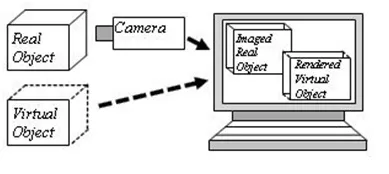Modern astonishing and top-notch innovations have been penetrating all spheres of our life. One of the miracles of human mind and the latest outstanding achievement is mobile augmented reality. To perceive the essence of any phenomenon, it’s quite reasonable to begin with its definition. Augmented reality is a vision of the real world through a device’s camera, where some parts of the reality are augmented (or supplemented) by video, graphics, sound or GPS system. Mobile augmented reality allows to combine real and virtual worlds, making the environment around the user interactive and controllable.
The diagram illustrates mixed reality explained by University College London. A real object is captured into virtual reality and mixed with an object created within virtual reality.
Mobile augmented reality is a rather new practice that causes both approval and distrust. Like it or not, but the fact that a user can superimpose digital data on the real environment, is pretty impressive. Augmented reality technologies are implemented on mobile devices in the form of applications that convert virtual information into the real world and enable users to access and comprehend incoming data more easily. In order to better understand what mobile augmented reality is about, we present some mobile augmented reality applications.
The first application that arouses interest is the one that allows to learn where tweet messages are coming from. More explicitly, when a user is moving around with a camera on, it has now become possible to figure out who is tweeting at that moment of time and where this person is situated.
Another augmented reality application that amuses mobile phones holders is a Layar application. This app enables developers to come up with their own supplemented reality by means of the layers they can put onto the real live videos.
Some of these applications not only impress but also prove useful for users. For example, there is a mobile augmented reality app that helps to get directions to the nearest subway station. It almost eliminates the need to ask for directions and the possibility of getting lost.
One other mobile application gives an amazing opportunity to recognize people by directing a camera at their face. Thus, a user can get contact information or even data taken from their online profile.
The next application is similar to the previous one, but apart from people it also recognizes objects (buildings, monuments, newspapers, etc.). It’s only a matter of pointing a phone’s camera at a historic landmark, city surroundings, or an article in a newspaper, when users get historical details, information about the place they are situated and the place they need to go to, or the possibility to share or forward news.
One more mobile augmented application can serve as a travel guide for a user. With this app life becomes so much easier when travelling abroad. Instead of buying a travel handbook or hiring a travel guide, it’s enough to just hold up a phone and get all information about a site you are interested in.
To learn more about the applications Elinext Alliance has developed look through our case studies
Having learned about some incredible possibilities mobile augmented reality gives to its users, it is also essential to realize what stands behind it. The development of augmented reality can be compared to the development of software, although while creating augmented reality more issues occur as you have to deal with its embedding into the real world.
First of all, to avoid objects appearing where they shouldn’t, it is necessary to think out an appropriate mobile vision and camera algorithm. Thus, one can be sure a user is pointing a camera at the right direction. Another thing that matters while programming augmented reality is selecting the right platform to develop for. Augmented reality technology can be developed not only for mobile phones. It can be elaborated for other platforms too, such as computers, tablets, GPS gadgets, headsets, etc.
Considering that the majority of mobile augmented reality programs are mainly aimed at recognizing an object, it is vital to pay proper attention to object’s appearance. For instance, if an augmented reality program is created to enable users find a shoe store, it is supposed to tell it from any other store. Therefore, one of the major tasks for mobile augmented reality is to recognize an object accurately. It is of great importance to equip the program with the ability to differentiate correct objects from the incorrect ones, as it may entail erroneous enhancement of the reality.
Moreover, the program should also recognize possible movements of an object to guarantee the accuracy of its displaying. If the program captures an object, it has to be able to capture it even if this object has moved or has been removed to some other place. It may seem insignificant, but the technology should go on capturing an object’s position even if it has already got out of sight. This possibility needs to be taken into account; otherwise, it will entail a great number of errors and failures.
As a matter of fact, the core task of the mobile augmented reality technology lies in enhancing current view of the reality. This core task is also the greatest challenge augmented reality programming faces: enhancing an object in the real world. To ensure the correct implementation of this task, developers need to regard where the user is looking and what he sees. Camera programming should be able to stop enhancing an object when a user distracts and the program gets idle.
A good example of a successful mobile augmented reality adoption is the IKEA mobile application. It was designed to help customers get a visual image of the desired interior. Now customers are able to actually fit a piece of furniture into their house. Mobile augmented reality solution gives a unique opportunity to combine real home environment with computer-generated data and get a complete view of the supposed design. This solution serves to move to a higher level of communication and establish mutually beneficial relations with clients.
Mobile augmented reality is a perfect way to access and comprehend information in an easy and entertaining way. This phenomenal technology facilitates human life by enabling people to emerge into the reality where two dimensions are brought together.
Industries and Technology Areas
Industries: advertising, entertainment, lifestyle, healthcare, education
Technology Areas: mobile augmented reality, mobile application development, iPhone, iPad, iOS, Android, smartphone, tablet, game development, mobile application development










